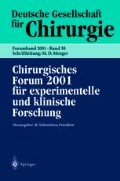Abstract
Introduction: Thermal in situ ablation techniques are of increasing importance in the palliative therapy of liver tumors. Only monopolar application systems have thus far been available for high-frequency thermotherapy (HFITT); their applicability is limited due to incalculable energy flows, reduced electrical tissue conductivity and limited lesion size. Accordingly, we developed a novel bipolar cooled HFITT application system, which was tested in vivo for the first time under experimental conditions. The aims of the study were to test the effectiveness of the procedure and evaluate the impact of interrupted hepatic perfusion on inducible lesion size. An established clinical application system for laserinduced thermotherapy (LITT) was used for comparison. Material and Methods: Thirty pigs (25 – 30 kg); laparotomy under i.v. anesthesia; six groups (n = 5). HFITT application (cooled bipolar applicator, Ø3 mm, electrode length 16 mm) was used in the groups HF and LITT (Nd:YAG laser, diffuser tip applicator) in groups LITT. Each animal underwent two to four applications using the highest possible energy/power for the application system. The applications were performed with maintained hepatic perfusion (groupmono), after i.a. application of degradable starch microspheres (DSM) via the hepatic artery (groupDSM) and after temporary occlusion of the hepatoduodenal ligament (groupPringle ). The liver was removed after the intervention. The lesion was then measured longitudinally (1) and transversally (t) to the applicator axes and the volume (V) calculated. Results: HFITT and LITT applications were free of complications. A volume increase was achieved in both procedures by interrupting hepatic perfusion (DSM/Pringle) ( p < 0.05 ). Less energy was applied in group HFPringle (34.2 ± 1.7 kJ) than in group HFmono (41.9 ± 1.3 kJ) (p < 0.01). The volumes in groupLITT Pringle with 60.2 ± 2.2 cm3 were larger than in group HF Pringle with 48.6 ± 4.3 cm3 (p < 0.005). The data are given in the table below (* =p < 0.05, Kruskal- Wallis test). Conclusions: (1) The bipolar HFITT applicator enabled reproducible induction of clinically relevant lesions comparable to the LITT applicator system. (2) Interrupting hepatic perfusion leads to a volume increase with both application systems. (3) Interrupted perfusion reduces the maximal applicable energy after HFITT but yields comparatively lower volumes than after LITT, which may limit the use of interrupted perfusion.
Access this chapter
Tax calculation will be finalised at checkout
Purchases are for personal use only
Literatur
Germer CT, Albrecht D, Roggan A, Buhr HJ (1998) Technology for in situ ablation by laparoscopic and image-guided interstitial laser hyperthermia. Semin Laparosc Surg 5: 195–203
Germer CT, Isbert C, Albrecht D, Roggan A, Pelz J, Ritz JP, Muller G, Buhr HJ (1999) Laser-induced thermotherapy combined with hepatic arterial embolization in the treatment of liver tumors in a rat tumor model. Ann Surg 230(1): 55–62
Goldberg SN, Gazelle GS, Compton CC, Mueller PR, Tanabe KK (2000) Treatment of intrahepatic malignancy with radiofrequency ablation: radiologic-pathologic correlation. Cancer 88: 2452–2463
Vogl TJ, Muller PK, Mack MG, Straub R, Engelmann K, Neuhaus P (1999) Therapeutic options in nonresectable liver metastases Percutaneous radiological interventions. Chirurg 70: 133–140
Author information
Authors and Affiliations
Corresponding author
Editor information
Editors and Affiliations
Rights and permissions
Copyright information
© 2001 Springer-Verlag Berlin Heidelberg
About this paper
Cite this paper
Germer, CT. et al. (2001). Vergleich eines neuen bipolaren Applikationssystems zur Hochfrequenzinduzierten Thermotherapie (HFITT) mit dem Diffuser-Tip-Applikator zur Laserinduzierten Thermotherapie (LITT) in der Therapie von Lebertumoren in vivo. In: Schönleben, K., Neugebauer, E., Hartel, W., Menger, M.D. (eds) Chirurgisches Forum 2001 für experimentelle und klinische Forschung. Deutsche Gesellschaft für Chirurgie, vol 30. Springer, Berlin, Heidelberg. https://doi.org/10.1007/978-3-642-56698-1_36
Download citation
DOI: https://doi.org/10.1007/978-3-642-56698-1_36
Publisher Name: Springer, Berlin, Heidelberg
Print ISBN: 978-3-540-41718-7
Online ISBN: 978-3-642-56698-1
eBook Packages: Springer Book Archive

